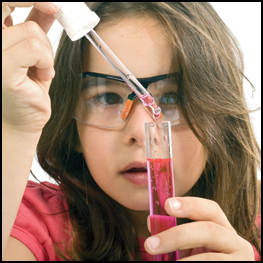
“Mom, do you have a 6-volt battery, two funnels, masking tape and some steel wool I can use?” My daughters ask questions like this – usually when I’m up to my elbows in dirty dishes. Buying science books to entice them had been easy, but following through was not. For months I had to answer, “I don’t know, and I don’t have time to look for them now.” Chances are you find yourself saying “no” to your kids’ ideas more often than you would like. Relax and say “yes” by creating a custom science box for your family.
Open up a world of exploration by following these easy steps:
Select a book of experiments. If your kids are already clamoring to try experiments in a book at home, you are all set to begin your supply list. If not, browse the library and bookstore shelves for a book your child will love and that is at their level. Consider your child’s age and how involved – or not involved – you will be with the experimenting. Our family has had great success with the Science for Every Kid series by Janice VanCleave, author of 50 best-selling science experiment books for children ages four through high school. Purchase the book your kids beg you to use, then gather supplies specifically for this book. Create a master supply-list. Once you’ve made your choice, sit down with the book and a piece of paper. If you are lucky enough to have chosen a book with a comprehensive list of supplies, turn to that page. Otherwise, start with the first experiment in the book and copy any supplies you do not have or would need to search for to complete the experiment. Do this for each experiment in the book; include any common household items you do not want to sacrifice to the science box. Do your kids already walk off with the masking tape? A new roll to keep in the science box can go on your list. Do not include basic items your kids have quick and easy access to.
Gather supplies. Grab a box or bag and fill it with items on your list that are already in your home. Invite your partner to check your list. Chances are there are things on the list one of you can locate quicker than the other. Do not underestimate what can be unearthed from the depths of the basement or garage. Next, determine where you can find the remaining items. Physics books in particular may warrant a trip to the hardware store, but search second-hand or dollar stores on your way. Round out your kit with a journal. An unlined spiral-bound book will lie flat and be easy to use, with space for drawings and notes. Include this to encourage your junior scientist to make and record observations – and to sneak some writing into their day. Tape or copy your master equipment list into the back of this journal. Use the back page to keep track of supplies as they are used up and you will always be ready to
restock.
Create your box. Get a sense of how much equipment you have, and don’t forget to put the science book and journal in your pile. Two yard sticks or other awkward items? Those aren’t going to fit reasonably in any container you choose, so store them separately. Once you have a grasp of how much you have, look for a permanent container for your collection. Use any type of container that suits your style and budget. A clear storage box with a lid that snaps on with clasps will keep things from spilling and provides a visual reminder of the fun to be had.
Finally, place all of your equipment, the science book and journal in your container, snap on the lid and you’re ready to go. The next time your child says, “Hey, mom! Can I do some experiments?” You can say, “Sure! Go get the science box!”
Books of Inspiring Experiments
Calgary’s Child Magazine © 2024 Calgary’s Child